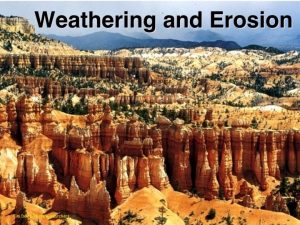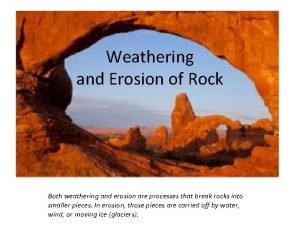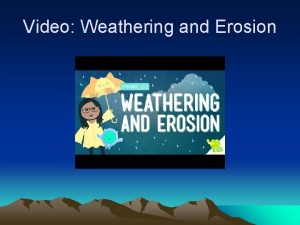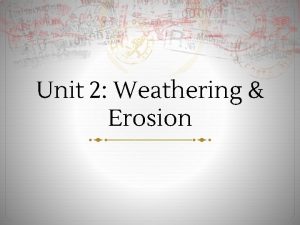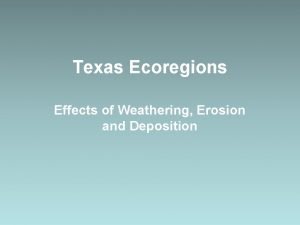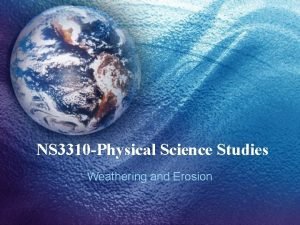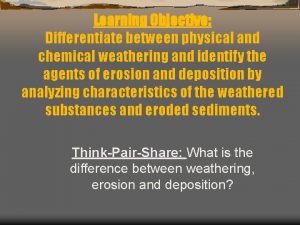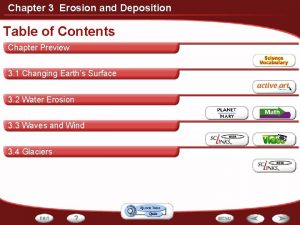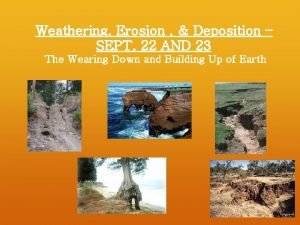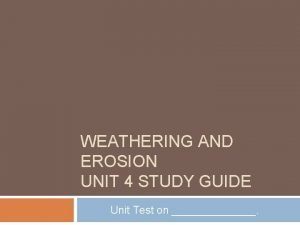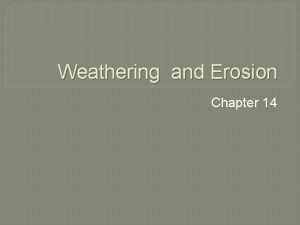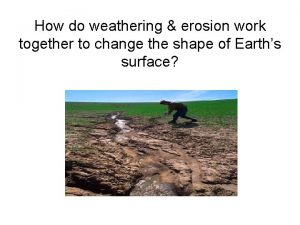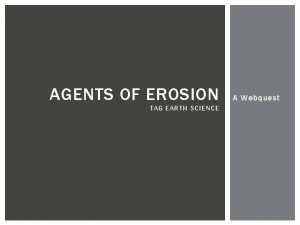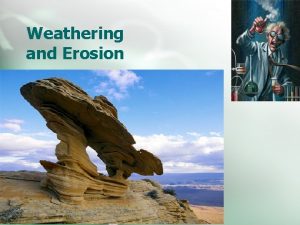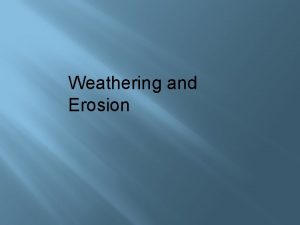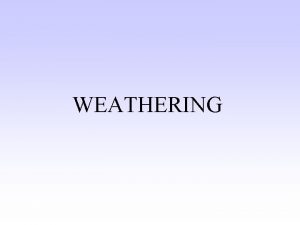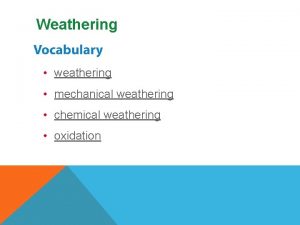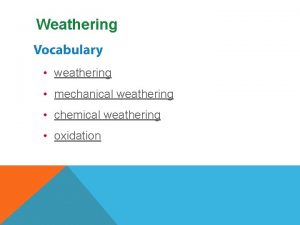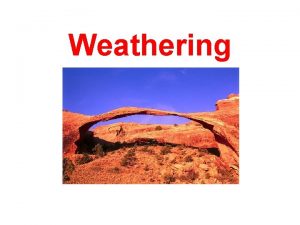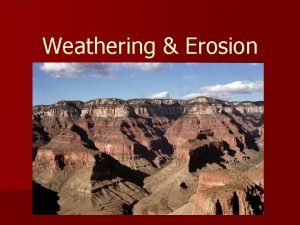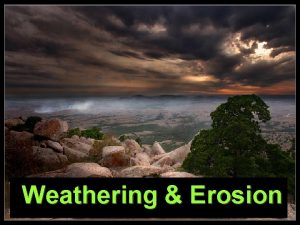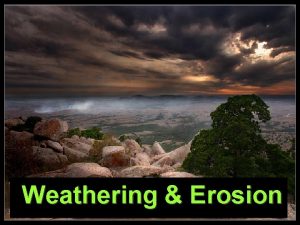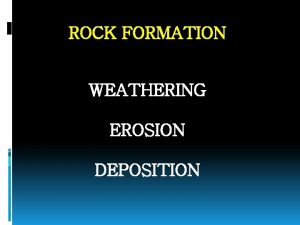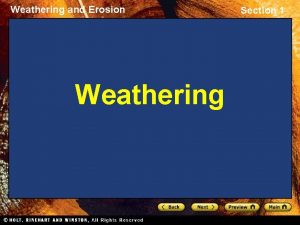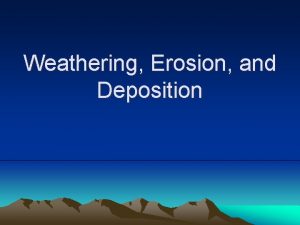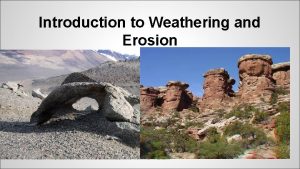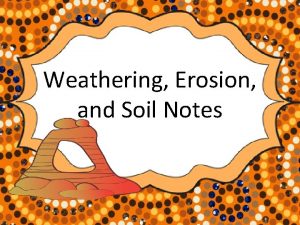Weathering and Erosion Weathering of Rock vs Erosion


















- Slides: 18

Weathering and Erosion Weathering of Rock vs. Erosion of Sediment

Weathering • The breaking of rock into sediment (bits and pieces of rock) • Two main types of weathering: – Physical/Mechanical – Chemical

1. Physical/Mechanical Weathering • Physical forces break rock down without changing mineral composition • 4 main causes of physical weathering: – Wind – Water – Ice – Biological

Physical Weathering: Wind • Acts via abrasion: small particles hit the rock and chip away small pieces at a time • Side facing the wind wears away the fastest

Physical Weathering: Water • Acts via abrasion: rock tumbles around and pieces are knocked off as it hits other objects in the water. • Rock becomes smaller, smoother, and rounder over time.

Physical Weathering: Ice • Acts via frost wedging: water gets into tiny cracks in the rock, freezes, expands, and makes the cracks larger until the rock splits.

Physical Weathering: Biological • Occurs via plant roots, burrowing animals, human mining, etc.

2. Chemical Weathering • Change in the composition of a rock due to acid rain • Often involves dissolving the rock

Rate of Weathering Factors • 3 factors can change the rate (speed) of weathering: – Climate – Topography – Rock composition

Rate of Weathering Factors: Climate • Rain: more rain = more chemical weathering • Wind: more wind = more physical weathering (wind abrasion) • Temperature: lower temperatures = more physical weathering (frost wedging)

Rate of Weathering Factors: Topography • Steep slopes = more weathering • Flatter slopes = less weathering

Rate of Weathering Factors: Rock Composition • Harder rock type = less weathering (it resists!)

Check for Understanding • Sort the provided picture cards into types of weathering. • When your group thinks you’ve got them all right, raise your hand for me to check. I will give you a thumbs up or tell you how many are incorrect.

Erosion of Sediment • The movement of weathered sediment from one location to another. • 4 main agents (causes) of erosion: – Gravity – Wind – Water (run off, rivers, oceans) – Ice (glaciers)

Rate of Erosion Factors • Rate (speed) of erosion is determined by: 1. Type/amount of vegetation 2. Gradient (steepness) of the slope 3. Climate

Rate of Erosion Factors: Type/Amount of Vegetation • Trees: deeper roots = slower erosion • Grass: shallow roots = faster erosion • NONE: no plants = VERY fast erosion

Rate of Erosion Factors: Gradient • Steep slope = faster erosion • Gentle slope = slower erosion

Rate of Erosion Factors: Climate • Wind – More wind = faster erosion – Less wind = slower erosion • Rain – More rain = faster erosion – Less rain = slower erosion
 Types of igneous rock
Types of igneous rock Control measures of soil erosion
Control measures of soil erosion Llano uplift weathering erosion and deposition
Llano uplift weathering erosion and deposition Difference between weather and erosion
Difference between weather and erosion Waves dropping sand on the beach is an example of what
Waves dropping sand on the beach is an example of what Bill nye weathering and erosion
Bill nye weathering and erosion Exfoliation definition weathering
Exfoliation definition weathering Weathering and erosion difference youtube video
Weathering and erosion difference youtube video Weathering and erosion questions
Weathering and erosion questions Cross timbers weathering
Cross timbers weathering Piney woods weathering
Piney woods weathering Agents of weathering
Agents of weathering Differentiate between chemical and physical weathering.
Differentiate between chemical and physical weathering. Weathering erosion and deposition
Weathering erosion and deposition Weathering and erosion
Weathering and erosion V shaped valley formed by
V shaped valley formed by Chapter 14 weathering and erosion review answers
Chapter 14 weathering and erosion review answers Dust bowl 1930s
Dust bowl 1930s Weathering webquest
Weathering webquest



